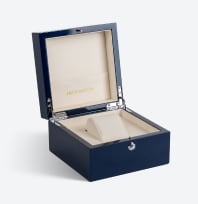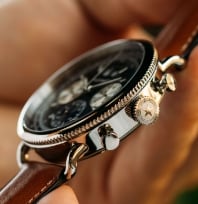A Brief Introduction To Watch Movements
There are three different types of mechanisms, known as movements, that are used by watchmakers when crafting watches to keep them ticking and telling time actively. These three types of movements are mechanical movement, automatic movement, and quartz movement.
Quartz movement, one of the most common watch-powering mechanisms in the modern market, relies on a battery rather than the traditional wound mainspring. The battery in a quartz watch emanates an electrical current that vibrates a piece of quartz. The vibrations of the quartz are at a precise frequency, and these precise vibrations regulate the ticking of the watch. Quartz watches are low-maintenance, lightweight, and remarkably simple in comparison to their mechanical predecessors.
Automatic movement, a direct descendent of mechanical movement, employs a weighted rotor mechanism to allow a watch to wind itself. As the wearer rotates his wrist while wearing the watch, the movements engage the weighted rotor, spinning to self-wind the mainspring inside the watch. The energy stored up by this mechanism allows for an automatic watch to keep ticking accurately for long periods of time without requiring manual winding by the wearer.
Finally, mechanical movement, the main focus of this post, is the forefather of automatic and quartz movement and the most elaborate and intricate of the movements. A mechanical watch relies on manual winding to tick. The wearer will wind the watch himself using a dial called a crown on the exterior of the watch.
Mechanical movement is the oldest of the movements, with a rich history spanning centuries of watchmaking. Mechanical watches are staggeringly intricate and fascinating to look inside. Inspecting the inner workings of a mechanical watch, you have to marvel at the ingenuity of watchmakers working in decades and centuries past who handcrafted such tiny components and made them work together in harmony.
These three types of watch movement all have devoted fans and followers in the modern era. However, mechanical movement has become somewhat antiquated with the advent of simple, lower-maintenance mechanisms of watch movement. Mechanical watches are still dearly loved by collectors and enthusiasts, but the movement has largely been overshadowed by automatic and quartz movements.
Even as mechanical watch movement’s popularity has waned, it has not become any less intriguing. In this post, we’ll take a deep dive into the inner workings of a mechanical watch, uncovering what’s going on under the surface of this incredibly intricate type of timepiece. Prepare to have your mind blown.
A Guide To The Key Components Of A Mechanical Watch
Mechanical watches are made from a wide array of small (sometimes incredibly tiny), interconnected parts. Below is a simple guide to the main components of a mechanical watch. After you familiarize yourself with these parts, we’ll move forward to discuss how each of the components of a mechanical watch work together to make the watch tick.
The key component in a mechanical watch that plays a crucial role in its winding is the mainspring. The mainspring is a small, circular piece of wound steel that is interconnected with a mechanical watch’s wheel train and escapement, which regulate the timing of the mainspring’s release of stored energy.
The wheel train attaches to the mainspring. A set of interconnected gears, the components of the wheel train turn at timed increments, regulated by the escapement. The escapement is a combination of some of the most delicate parts of the watch. Inside the escapement assembly are the balance wheel, regulator, and hairspring, which maintain the watch’s rate of released energy from the mainspring. This regulation keeps the watch ticking accurately.
To keep a mechanical watch ticking, power must be released from the mainspring and regulated by the escapement. To regulate this release, the escape wheel, a component in the escapement, is held in place by a pin. As the balance wheel in the escapement rotates, the pin periodically releases the escape wheel, allowing it to spin. When the escape wheel spins, the mainspring is unwound in tiny increments, known as beats.
Why Does A Mechanical Watch Tick?
Mechanical watches tick thanks to a “click” inside the escapement each time the pin that holds the escape wheel catches the teeth of the wheel. When the balance wheel allows the escape wheel to spin, the pin that holds the escape wheel in place is lifted, catching the escape wheel and making a soft ticking noise.
The “beats” of the spinning escape wheel occur approximately six times per second, translating to 21,600 beats per hour. That means a mechanical watch is “ticking” more than once per second and that the ticks do not correspond to the passing of seconds. Instead, a mechanical watch’s ticks are the natural noise generated by the movement of the escape wheel.
What Holds A Mechanical Watch Together?
The delicate mechanism inside a mechanical watch that keeps it ticking is held up by a sturdy support system. The bottom of a mechanical watch is called the main plate. The main plate holds all of the inner mechanisms of the watch together, supporting them and keeping them from shifting out of place.
Atop the main plate, a mechanical watch contains a series of layers of gears, cogs, and interconnected mechanisms known as bridges. The balance bridge, directly on top of the main plate, holds the balance wheel, the most delicate component of a mechanical watch. The balance wheel’s oscillation triggers the release of the escape wheel, allowing for energy to be released as the mainspring unwinds.
Above the balance bridge is the pallet bridge, which houses the pallet fork of the watch. Attached to the balance wheel, the pallet fork houses the escape wheel, periodically releasing it as the balance wheel oscillates. This oscillation and release allow the escapement to regulate the release of energy from the watch’s mainspring.
On top of the pallet plate is the wheel train bridge. The wheel train is the series of interconnected gears that connect the escapement and the mainspring. Without the wheel train, the escapement would not be able to regulate the release of energy from the mainspring.
Finally, the top bridge layer of a mechanical watch is called the barrel bridge. This layer houses the mainspring, connecting it to the wheel train and escapement.
Every Part Matters
Each of the components in a mechanical watch plays a key role in regulating the release of energy from the mainspring. Without the delicate balance of the parts working together, a mechanical watch would be inaccurate or non-functioning. The abundance of moving parts creates a lot of potential for problems requiring expert attention. However, as high-maintenance as they are, mechanical watches are truly fascinating inventions, powered by a combination of human ingenuity and expert craftsmanship.
The intricacies of a mechanical watch make these timepieces both works of art and collectors’ items. Mechanical watches are often appraised at thousands of dollars due to the craftsmanship and artistry behind them. These watches may also be beautifully embellished, and some are made of gold or other precious metals. Ultimately, all of these factors have made mechanical watches more of antique collectibles than accessories fit for everyday wear.
Why Did Mechanical Watches Decline In Popularity?
Overall, the decline in the popularity of mechanical watches came as a result of innovation in watchmaking. Automatic and quartz movement gave watches previously unseen levels of convenience and accessibility to wearers. With less need for maintenance and fewer fragile moving parts, automatic and quartz watches became the industry standard as the 20th century unfolded.
In the early 20th century, automatic wristwatches became widely accessible to the public. After World War I, there was a surge of innovation in many industries, watchmaking notwithstanding. From this surge came the popularity of automatic watches, which offered a new level of convenience to wearers.
Whereas mechanical watches required manual winding to keep ticking and telling time accurately, the first automatic watches were inherently lower-maintenance thanks to the presence of a weighted rotor mechanism. This mechanism, attached to a similar mainspring to the one found in a mechanical watch, allows an automatic watch to wind itself as the wearer moves his wrist.
A few decades later, in the late 1960s, legendary watchmakers Seiko introduced the first quartz watch. Quartz watches, powered by batteries, were even more low-maintenance and user-friendly than their automatic or mechanical predecessors. These watches’ batteries vibrate an embedded piece of quartz at a specific frequency, allowing for remarkable levels of accuracy. The battery-powered mechanism in a quartz watch is also much lighter than the weighted rotor mechanism in an automatic watch.
If you are lucky enough to own a mechanical watch, hang onto it. These incredibly intricate timepieces are worthy of being family heirlooms, passed down through generations with great symbolic significance. While mechanical watches may not be the most practical option for the modern man, their ingenuity and the expert craftsmanship behind them is undeniable.
Sources:
https://electronics.howstuffworks.com/gadgets/clocks-watches/question285.htm
https://www.esquire.com/uk/watches/g9664/9-most-expensive-watches-in-the-world/
https://www.businessinsider.com/mechanical-watches-worth-buying-2016-9









